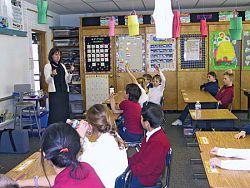St. Olaf students raise $1,119 for Make-A-Wish

BOUNTIFUL — The St. Olaf fourth grade students in JaNeal Rodriguez’s class raised $1,119 for the Make-A-Wish Foundation of Utah. The money they raised helped John’s wish come true. John is 9 years old and he has a liver disease. He and his eight brothers and sisters went to Disney World in Florida. "The Make-A-Wish Foundation grants wishes for children with life-threatening illnesses, or medical conditions. This does not mean these children are going to die because some of the children whose wishes are granted do survive their illnesses," said Debbie Mintowt, director of Marketing and Development for the Make-A-Wish Foundation. "If the children qualify to have their wishes granted, it means they have something serious like cancer, cystic fibrosis, or they might need a heart or liver transplant. Some of the children have a really good chance of surviving." Mintowt said if getting a wish granted meant for sure these children were going to die, many parents would not want their children’s wish granted. They would not want to think their child was going to die. It would also make her job really hard and unbelievably sad. Make-A-Wish grants wishes to send a message to children, not to give them something material. The message is that the Make-a-Wish Foundation, together with the children’s family members and community, love and care about these children. Having wishes granted gives children hope, joy, and the strength to survive. There are four kinds of wishes Make-A-Wish grants: I wish to travel to…, I wish to meet…, I wish to have something, and I wish to be a…, which is a fantasy wish. Children are asked to declare three wishes in case the first wish cannot be granted, either because of the child’s health and the doctor will not authorize it, or it might be a wish they would not want to grant. For example, one child wished to hunt jungle animals. The foundation decided it would not be smart to give a child with a life-threatening illness a gun. So they did not grant that wish, but granted another wish he had requested. "Make-A-Wish is special for children who live in Utah or California because there is a foundation in these two states," said Mintowt. "The foundation in Utah only grants wishes for children living in Utah. Children who are eligible to make a wish are those with a life-threatening disease between the ages of 2 and one-half and 17 years." Mintowt read the students a story written and illustrated by Daxton, a 4-year-old boy who had a brain tumor and died four years ago. His wish was to go to Disneyland. His story is about himself as the superhero, cancer as the bad guy, and Capt. Chemo and Capt. Radiation as the good guys. Mintowt said all of the children for whom they grant wishes are superheroes because they all have to overcome going to the hospital when they are very sick and possibly have to stay for a long time. They have to undergo painful surgeries or treatments, and they must deal with knowing they might soon die. Daxton’s story shares the reality of what it is like to be really sick. Mintowt said even though Make-A-Wish grants wonderful wishes for children, being sick is not something you would want so you could have your wish granted. Most of us would prefer to be healthy. Rodriguez said the 21 students in her class raised the money by making crafts at home and in class. They sold the crafts to the other students in the school. The students planned on having a two-day sale, but sold out of items the first day. So that night Rodriguez and others had to make more items or get items donated. The sale was Dec. 15-16, and timely for Christmas gifts, stocking stuffers, and Christmas decorations. This started as a junior achievement service project in which the students were learning about businesses and companies. Once they chose where the money they raised would go, they named their business Merry Christmas to Make-A-Wish. Each student had his or her own company, which fed into the larger class company. The first day the students raised $600, and they only expected to raise a total of $300 for both days. Some of the items they made were snowman bookmarks, scarves, personalized ornaments, neck-roll pillow sets, and door hangers. The students thought of a project for themselves, and then the class compiled a list of what they needed, and the parents donated the supplies. The students learned from this project what it is to have a business, to advertise, and to make a product. They also learned about giving and why giving is so important.
© Copyright 2024 The Diocese of Salt Lake City. All rights reserved.

Stay Connected With Us